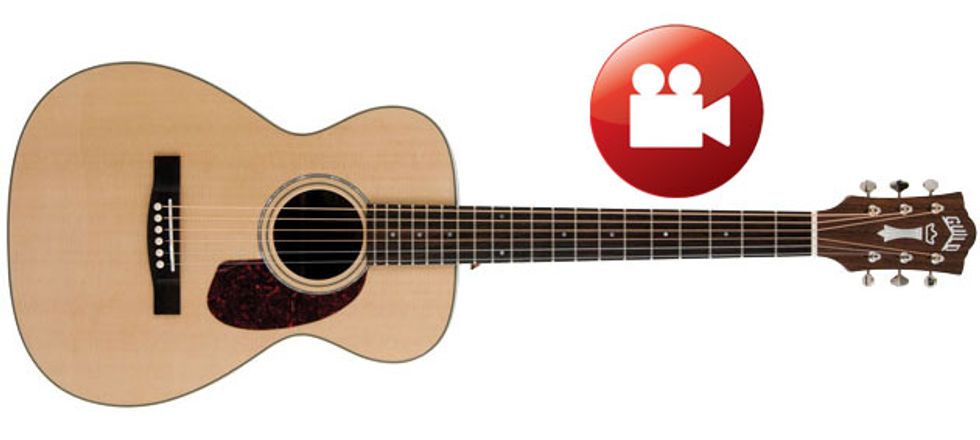
In 1966, Guild Guitars—then just 13 years into its existence—moved from Hoboken, New Jersey, to Westerly, Rhode Island. Today, many players and collectors love those Rhode Island-built instruments, particularly ones from the mid ’60s. They were well made at a time when some bigger companies were seeing quality slip, and several of these Guilds—acoustics, electrics, and basses—became axes of choice for young, rule-breaking players of the era. The Rhode Island instruments were also original and innovative: That cutaway dreadnought profile that’s so ubiquitous now was a pioneering move by Guild in 1972.
Guild recently changed hands after a few decades in the hands of Fender, moving its headquarters to Oxnard, California, where it’s now a subsidiary of Cordoba Music Group. Given this change, it’s no surprise the company would reassert its roots and history by lending the Westerly handle to this new line of Chinese-built acoustics. The guitars pay homage to Guild’s Rhode Island history in more than name, however. Several classic Guild body styles turn up in the line, including the concert-sized M-140E reviewed here.
Functionally Classic
With a solid Sitka spruce top and solid mahogany back and sides, the M-140E is an attractive guitar with just enough upmarket details to feel a bit fancy without spoiling the intrinsically attractive lines. It sports the same headstock logo seen on ’60s Guilds, a vintage-looking tortoiseshell pickguard, and open-geared tuners that add to the old-school effect. More luxurious details, like a mother-of-pearl rosette and rosewood headstock cap, are nice flourishes. And the Fishman Sonitone electronics offer amplification flexibility via discrete, soundhole-mounted controls rather than a hunk of plastic on the side of the guitar.
Our review M-140E is very nicely built. The mahogany in particular has beautiful grain structure and coloration, and all of the binding is tight and flush with the body. The NuBone nut and saddle are perfectly notched, and the fretwork is clean. Bracing and kerfing are all tidy, too. My only minor complaint might be the high-gloss polyurethane finish, which is applied a bit thick in spots.
Compact Comfort
The M-140E’s diminutive dimensions make it very comfortable to play. The mahogany neck has a comfy, C-shaped profile, and the 24 3/4" scale and wider, 1 3/4" nut make stretchy chords and fingerstyle moves feel easy. The action is perfect—low but not overly so—and the neck is free of dead spots and fret buzz.
Ratings
Pros:
Solid-wood construction. Nice sounds and playability. High-quality electronics.
Cons:
Slightly weak bass response. Minor finish issues. Could be more competitively priced.
Tones:
Playability:
Build/Design:
Street:
$850
Guild Guitars M-140E
guildguitars.com
Meanwhile, its voice has many of the classic, mahogany-backed small-body attributes: It’s warm and slightly compressed, with impressive midrange response and strong fundamentals. The guitar also has great dynamic response for a small-bodied instrument—thanks, no doubt, to the Sitka top. Not surprisingly, the guitar works terrifically well for fingerstyle country blues, and the fast response makes it very sensitive to picking nuance.
Nick Drake used a concert-sized Guild (an all-mahogany M-20), so it was only natural to try a couple of his pieces on the M-140E. The accompaniment for “Cello Song” (which has the 3rd string tuned down to F# and a capo at the 6th fret) benefitted from the instrument’s warmth, but the main pattern of “Fly” (slackened B–E–B–E–B–E tuning, 4th-fret capo) suffered from the 6th string’s slightly anemic response.
The M-140E works pretty well as a strumming guitar, though Carter-style patterns required a little extra emphasis in the bass and a lighter touch on the high strings to get the most balanced sound. Single-note lines are especially satisfying, though. The guitar has a sweet, natural reverb that lends expansiveness, and the high end is never thin or brittle. Chord melodies benefit from these same qualities, with individual notes in tightly voiced chords sounding clearly and with great separation. The Sonitone pickup sounds very natural too, and does an excellent job of communicating such harmonic details.
The Verdict
At about $850 street, the Guild is a fair value for an all-solid-wood guitar, though small miscues like the thick finish hold it back from being a superb deal. The M-140E might not feel exactly like a classic Guild, but it’s a very nice little guitar in all regards—well built, excellent sounding, and easy to play.
Watch the Review Demo:





















